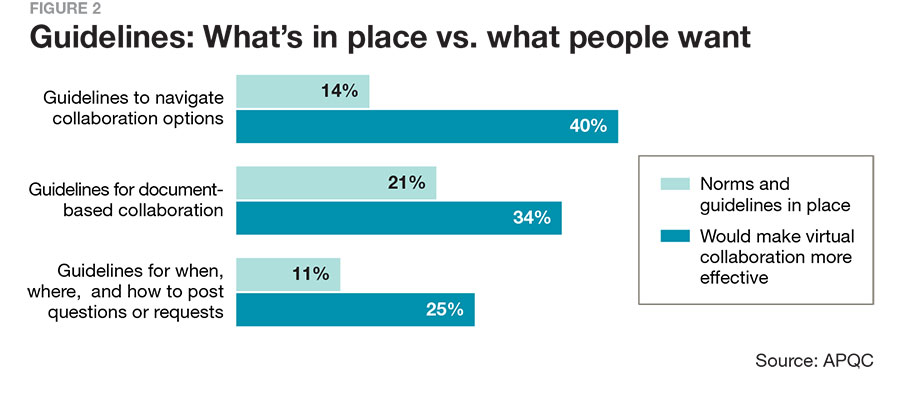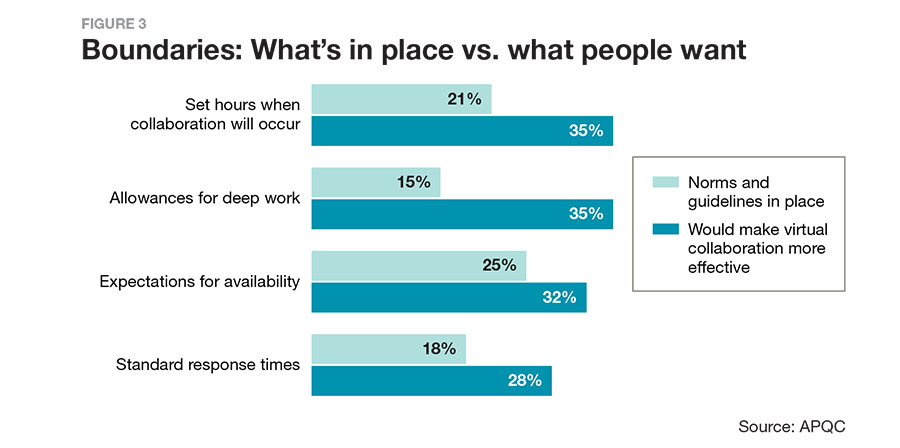Collaboration has always been integral to supply chain management success. Supply chain professionals must collaborate and share information with internal stakeholders across functions to achieve organizational goals. They must also build and maintain close relationships with a variety of external partners including suppliers, logistics providers and customers.
When the COVID-19 pandemic hit, almost all forms of organizational collaboration, including supply chain collaboration, went virtual. Although the shift to remote work and virtual collaboration was abrupt, it’s likely to endure as organizations have already realized significant benefits in terms of costs, productivity and risk management.
In this article, we will look at the current state of virtual collaboration, what it means for supply chain management and five keys to ensuring successful and sustainable virtual collaboration in 2021.
The current state
We all know how big the shift to virtual work felt within our own organizations, but APQC’s “Virtual Collaboration: Rules of the Road” research conducted in the fall of 2020 shows just how drastic it was. Before COVID-19, 57% of survey respondents interacted with coworkers primarily in person. In the aftermath of the pandemic, 84% said their coworker interactions were primarily virtual (Figure 1).

The move to virtual and hybrid work is not a flash in the pan. Many organizations have given up their office leases or moved to shorter and more flexible terms. Millions of newly remote employees have relocated from expensive, close-to-work cities to more affordable suburbs and small towns. That both executives and employees are making such big moves suggests that virtual work is here to stay.
Indeed, while APQC’s research identified some important challenges with virtual work, 75% of respondents said that they are satisfied overall with the current state of virtual collaboration in the workplace. When APQC asked about the biggest benefits of virtual collaboration, 65% of respondents said that they appreciate the time they save commuting and traveling. Other top benefits revolve around efficiency: People said that discussions are more to-the-point and they can get work done faster.
However, it’s also clear that virtual collaboration works better for some things than it does for others. Respondents said they’re struggling to use virtual tools for more creative, complex forms of collaboration such as innovation and problem solving. And when it comes to collaborative activities that require trust and social capital, such as change management and team building, virtual isn’t working as well as face-to-face once did. In a virtual setting, it’s hard to replicate unstructured and serendipitous exchanges—or in other words, to recreate the conversations that used to happen around the watercooler.
Many employees are frustrated with the lack of guidance and ground rules around virtual collaboration. Survey respondents pointed to the following problems:
- a lack of sufficient norms and policies to guide virtual collaboration;
- too many overlapping or disconnected apps or platforms; and
- insufficient training on how to collaborate virtually.
More than half of respondents said that their organization either has no guidelines for virtual collaboration or that norms emerge ad hoc as groups work together. APQC also found that when organizations do have guidelines, the communication around them is mostly reactive rather than proactive. Thus, while people say they’re satisfied with virtual collaboration now, some big problems are brewing. If this is to be a longer-term change, organizations can’t keep treating it like a stopgap measure that was thrown together in a crisis.
Supply chain implications
Supply chain management discussions about collaboration tend to focus on external collaboration. In 2020, that focus was perhaps even stronger as supply chain professionals leveraged their external partners to help navigate supply shocks and overloaded transport systems. External collaboration will remain vital in 2021, but supply chain professionals must also take a close look at their internal collaboration practices this year.
APQC finds that strong, sustainable collaboration builds from the inside out. Organizations must first develop an internal culture of collaboration before extending the effort to include partners. For supply chain, this is particularly important as maintaining mutually beneficially relationships ensures processes are not interrupted. Creating and maintaining a collaborative culture requires deliberate decisions about how and when employees will collaborate as well as what guidelines and norms they will follow. In 2020, these deliberate decisions, guidelines and norms were often lacking. Organizations can be forgiven for deploying ad hoc approaches in such a chaotic time, but this year must be better.
5 keys to success and sustainability
Supply chain organizations can fix current-state pain points and lay the groundwork for more successful, sustainable virtual collaboration. These are levers that can and should be pulled by all levels of management. Chief supply chain officers and VPs of sourcing and procurement, logistics, distribution and other executives should provide senior-level advocacy for these changes—but managers must help disseminate them and model desired behaviors.
Make virtual meetings limited and purposeful. Employees have experienced a dramatic upsurge in the number of virtual meetings. APQC’s research found that virtual meetings, both video calls and audio meetings with screen sharing, became significantly more critical in the wake of the pandemic. In a remote or hybrid workplace, video meetings are key to getting work done, building and maintaining relationships and obtaining information and expertise.
Despite how important virtual meetings are, few organizations have clear guidelines around them. Only 8% of organizations have limits on the number of meetings or their frequency, and only 35% have established criteria for meetings (e.g., requirements to share agendas ahead
of time). Here are six steps for improving
virtual meetings.
- Avoid making meetings the default form of communication. Use chat and email when possible, saving virtual meetings for when more immediate or deeper interaction is needed.
- Replace big, long meetings with smaller, shorter ones. When possible, have check-ins with individuals and small teams instead of calling everyone to a single “all-hands” meeting.
- Use video but allow for breaks. Ask participants to turn on cameras at the beginning and during discussions but allow people to turn cameras off when they’re not speaking.
- Require invites to include objectives and an agenda. If organizers send out agendas ahead of time, employees will have the information they need to decide whether to accept the invite.
- Empower people to decline if they don’t need to be there. In most organizations, it’s easy for any employee to invite anyone to a meeting at any time. Management needs to set the expectation that it’s okay to decline to attend unnecessary meetings.
- Emphasize that necessary meetings require full attention. Employees will be less tempted to multitask when meetings are shorter, more focused and less frequent.
Get people outside their bubbles. APQC identified a massive upswing in team-based virtual collaboration in 2020, with 59% of people rating team and project sites as highly critical to work. However, we did not see the same upsurge in cross-boundary collaboration. Employees are working virtually but still relying on the
networks they built in the physical office.

One effective method to encourage deeper, more complex forms of collaboration—such as brainstorming and innovation—is communities of practice. Communities of practice are fluid networks of cross-functional people who come together to share, discuss and learn from each other around a common discipline or topic of interest. They’re a great place for employees to build their networks and participate in unstructured yet focused discussions around work-related topics.
Streamline options—and clarify what happens where. APQC found that people really want guidelines around when, where and how to use virtual collaboration tools. They want to understand which apps to use, how to decide between different options and channels, how to collaborate on documents and where to put questions and requests (Figure 2).
Employees also want limits on virtual groups and channels. In most organizations, anyone can create a new group or add someone to a group with a touch of a button. That might sound empowering and exciting, but over time, it becomes exhausting as employees struggle to keep up with all their groups and remember which discussions happened where.
Establish norms and guidelines. In a physical office, managers visibly model collaboration norms and set the tone for how employees should (and should not) speak to each other. But many managers are not doing this in the virtual workplace. As a result, employees are making up the rules as they go, taking it upon themselves to self-police the virtual environment. This might be okay in the short-term, but it’s not sustainable. In fact, the New York Times reports that “Office conversation at some companies is starting to look as unruly as conversation on the Internet,” complete with off-color remarks, political debates and cyber bullying.
Five tips for bringing order to the current state of chaos include:
- Set clear rules and expectations, including a code of conduct, for the virtual workplace.
- Involve people-oriented functions (like HR) in aligning expectations with organizational policies and procedures.
- Create targeted training for leaders and managers so they can effectively model and reinforce behaviors.
- Find ways to recognize employees for exhibiting desired behavior.
- Provide a path to escalate serious issues such as cyber bullying.
Empower people to set boundaries for collaborative time. APQC found that many employees want boundaries around when virtual collaboration will and will not occur, but few organizations currently provide them (Figure 3).
APQC also found that the lack of boundaries is taking a toll on employee productivity and satisfaction. Setting boundaries at the organization, function and department level, often differentiated by role, can help address this. Managers should clarify and reinforce expectations for each employee and help identify the best-fit ways for employees to mark off time for their most important work.

Key takeaways
Setting clear guidelines and ground rules is key to building a sustainable, successful collaborative culture in a virtual context. It’s especially important for supply chain professionals to get this right, as mistakes and frustrations with internal collaboration can easily spill over into collaboration with suppliers and other external partners.
About APQC
APQC helps organizations work smarter, faster, and with greater confidence. It is the world’s foremost authority in benchmarking, best practices, process and performance improvement, and knowledge management. APQC’s unique structure as a member-based nonprofit makes it a differentiator in the marketplace. APQC partners with more than 500 member organizations worldwide in all industries. With more than 40 years of experience, APQC remains the world’s leader in transforming organizations. Visit us at apqc.org and learn how you can make best practices your practices.
SC
MR


Latest Supply Chain News
- How S&OP provides the answer to in-demand products
- AI, virtual reality is bringing experiential learning into the modern age
- Humanoid robots’ place in an intralogistics smart robot strategy
- Tips for CIOs to overcome technology talent acquisition troubles
- There is still work to do to achieve supply chain stability
- More News
Latest Podcast

 Explore
Explore
Business Management News
- How S&OP provides the answer to in-demand products
- AI, virtual reality is bringing experiential learning into the modern age
- Tips for CIOs to overcome technology talent acquisition troubles
- There is still work to do to achieve supply chain stability
- Blooming success: The vital role of S&OE in nurturing global supply chains
- Supply chain salaries, job satisfaction on the rise
- More Business Management
Latest Business Management Resources

Subscribe

Supply Chain Management Review delivers the best industry content.

Editors’ Picks





